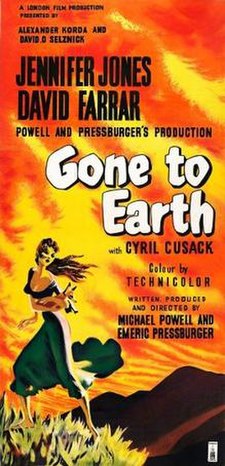Gone to Earth (film)
| Gone to Earth | |
|---|---|

theatrical release poster
|
|
| Directed by |
Michael Powell Emeric Pressburger |
| Produced by | Michael Powell Emeric Pressburger |
| Written by |
Mary Webb (novel) Michael Powell Emeric Pressburger |
| Starring |
Jennifer Jones David Farrar Cyril Cusack |
| Music by | Brian Easdale |
| Cinematography | Christopher Challis |
| Edited by | Reginald Mills |
|
Production
company |
|
| Distributed by | British Lion Films (UK) |
|
Release date
|
6 November 1950 (UK) |
|
Running time
|
110 minutes |
| Country | United Kingdom |
| Language | English |
| Box office | £110,000 (UK) |
| The Wild Heart | |
|---|---|

1952 poster
|
|
| Directed by | Rouben Mamoulian (add'l scenes, uncredited) |
| Produced by | David O. Selznick (uncredited) |
| Written by | Rouben Mamoulian (add'l scenes, uncredited) |
|
Production
company |
|
| Distributed by | RKO Radio Pictures |
|
Release date
|
July 1952 |
|
Running time
|
82 minutes |
Gone to Earth (1950) is a British Technicolor film by the director-writer team of Michael Powell and Emeric Pressburger. It stars Jennifer Jones, David Farrar and Cyril Cusack and features Esmond Knight. The film was significantly changed for the American market by David O. Selznick and retitled The Wild Heart in 1952.
Gone to Earth is based on the 1917 novel of the same name by author Mary Webb. The novel was all but ignored when it first appeared, but became better known in the 1930s, as the neo-romantic revival gathered pace, even inspiring a 1932 parody, Stella Gibbons's novel Cold Comfort Farm.
Hazel Woodus (Jennifer Jones) is a child of nature in the Shropshire countryside in 1897. She loves and understands all the wild animals more than the people around her. Whenever she has problems, she turns to the book of spells and charms left to her by her gypsy mother.
Local squire Jack Reddin (David Farrar) sees Hazel and wants her, but she has already promised herself to the Baptist minister, Edward Marston (Cyril Cusack). A struggle for her body and soul ensues.
Filming on Gone to Earth, which was shot in Technicolor, began on 1 August 1949. Studio filming took place at Shepperton Studios in Shepperton, Surrey, while most of the film was shot on location at many sites around Much Wenlock in Shropshire, England. Many local people were recruited as extras; for instance, the choir from the local Methodist church appears in the film. When director Michael Powell heard them sing, he thought they weren't ragged enough to portray a choir of "country folk", only to be told "But we are country folk, Mr. Powell."
...
Wikipedia
